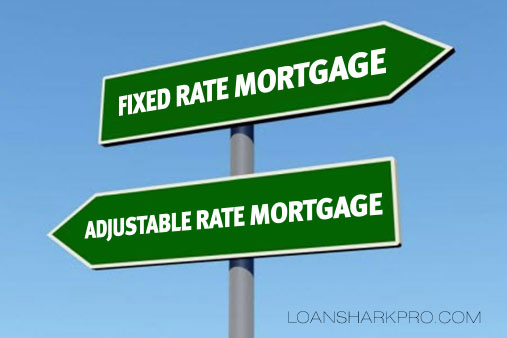
With a fixed rate mortgage, the interest rate and the amount you pay each month remain the same over the entire mortgage term, traditionally 15 or 30 years. A few variations are available, including five- and seven-year fixed rate loans with balloon payments at the end.
With an adjustable rate mortgage (ARM), the interest rate fluctuates according to the interest rates in the economy. Initial interest rates of ARMs are typically offered at a discounted interest rate that is lower than the rate for fixed rate mortgages. Over time, when initial discounts are filtered out, ARM rates will fluctuate as general interest rates go up and down. Different ARMs are tied to different financial indexes, some of which fluctuate up or down more quickly than others. To avoid constant and drastic changes, ARMs typically regulate (cap) how much and how often the interest rate and/or payments can change in a year and over the life of the loan. A number of variations are available for adjustable rate mortgages, including hybrids that change from a fixed to an adjustable rate after a period of years.
Understanding Fixed Rate Mortgage
The most common refinancing for mortgages is fixed rate. These loans feature fixed rates and monthly payments, generally for 15-year and 30-year periods. They are popular because consumers balk at the thought of their house payment rising and falling with interest rates. Whenever rates are low, fixed rate mortgages are very affordable.
Refinancing into a fixed-rate mortgage provides the peace of mind of knowing what the mortgage payment will be for the life of the loan (excluding property tax fluctuations).
Fixed rate loan borrowers face a major choice: 15-year or 30 year? For some a 30-year loan makes more sense. For others, a 15-year one does. Here are some pros and cons of each:
Advantages of a 30-year loan:
- Offers the chance to borrow money on a long-term basis without having to worry about the interest rates or payments changing.
- Monthly payments are lower than those on 15-year loans because the interest is amortized over a longer period.
- Lower monthly payments free up money that borrowers can pour into investments that yield more than their homes. For instance, in a bull-market economy, you can make more money investing the difference saved each month in mutual funds or other investment securities.
- A higher interest bill increases the amount consumers can deduct at tax time, potentially reducing or eliminating their federal income tax liabilities.
Disadvantages of a 30-year loan:
- Borrowers build equity at a very slow pace because payments during the first several years go largely toward interest rather than principal.
- The overall interest bill is much higher because of the long amortization term.
- The interest rates are higher than on 15-year loans.
Advantages of a 15-year loan:
- Borrowers build equity much more quickly due to shorter amortization schedules.
- Overall interest bills are dramatically lower than those on longer-term loans.
- The interest rates are lower than 30-year loans.
Disadvantages of a 15-year loan:
- Monthly payments can be significantly higher than those on 30-year loans.
- Restricts homebuyers to a smaller house than they might be able to afford with longer-term loans.
While 15-and 30-year loans are most common there are other options for a fixed-rate mortgage:
Biweekly Mortgages
Biweekly Mortgages let the calendar work for you. With a Biweekly Mortgage you make a mortgage payment every 14 days, instead of once a month. The result? By making smaller payments more frequently, you will pay off your mortgage sooner and save thousands of dollars in interest over the life of the mortgage.
A Biweekly Mortgage gives you the stability of a fixed-rate mortgage and the convenience of having payments automatically deducted from your checking, savings, or other deposit account.
Key features of the Biweekly Mortgage are:
- By making more frequent payments, you pay off the mortgage much sooner. For example, with a Biweekly Mortgage, a loan that normally takes 30 years to pay off will take 22 years to pay off at current interest rates. You will then own the home debt free and have saved 8 years’ worth of interest payments!
- Your mortgage payment is deducted automatically from your checking, savings, or other deposit account every 14 days-26 or 27 times a year in all. Many people find this an easy way to manage payments, especially if they pay their mortgage at the same time as they receive a biweekly paycheck. The Biweekly Mortgage requires no additional monthly fees, either.
Balloon Mortgage
The Balloon Mortgage is a fixed-rate mortgage with a term of seven years. The principal and interest are amortized over a longer period (30 years) than the actual term of the mortgage. At the end of the balloon period, you may pay off the outstanding balance with a lump-sum payment or exercise the option to refinance for the remaining term.
Balloons are not a common option for refinancing. The option to refinance is conditional, meaning you have to meet certain conditions (such as a history of timely payments or no second liens on your property). Conditions may include payment of closing costs and a lender fee, as well as no 30-day late payments in the previous 12 months and no other liens on your property. You must occupy your property at the time of refinancing. You need not re-qualify for this loan when refinancing at the end of seven years as long as the new interest rate is not more than 5% above the current interest rate. The refinance condition is not automatic-you must exercise the option.
Key features of the Balloon Mortgage are:
- This mortgage is ideal if you plan to sell or refinance your home within seven years and want a low monthly payment during that time.
- The interest rate you pay on a balloon mortgage is usually lower than a comparable 30-year fixed-rate mortgage.
- The refinance option provides a “safety net” in case a planned relocation doesn’t take place or economic conditions prevent you from moving to a larger home.
Interest First Mortgage
With an Interest First Mortgage, you pay only the interest, taxes and insurance in the beginning years of your mortgage, which means lower monthly payments. And, because the monthly payments are lower, you may qualify for a larger mortgage amount.
Key features of the Interest First loan include:
- Interest First is available to buy or refinance a 1-unit home that you will live in as your primary residence or a second home.
- With Interest First, you can select a 30-year fixed-rate mortgage, with an interest-only period of either 10 or 15 years. After the interest-only period ends, either in the 11th or 16th year, your monthly payment increases to include repayment of principal (the original loan amount) and interest. But by then, you have had many years of lower monthly payments and the ability to use your money for other expenses or investments.
- Interest First Adjustable Rate Mortgages (ARMs) can be originated with interest-only periods that match the initial fixed-period (3-, 5-, 7- or 10- years) or with a 10-year interest-only period. Your payment using the ARM option may even be lower than with the fixed-rate mortgage. And, the 10-year interest-only option will help to reduce the potential payment shock at the end of the initial interest rate period.
- You can prepay principal at any time during the interest-only period-for example, if you receive a bonus or increase in earnings. This reduces the future interest-only payments, since you would be paying interest on a lower principal amount. You can also prepay principal during the fully amortizing period. Although these prepayments do not change the scheduled payments or term, they let you pay off the mortgage sooner and thus pay less interest than originally scheduled.
Understanding Adjustable Rate Mortgages (ARM)
Homeowners often choose to refinance to adjustable-rate mortgages (ARMs) when interest rates are high, or when they want to trade in a higher fixed-rate mortgage for a lower-rate ARM. Loan terms will vary among lenders, but generally, adjustable-rate mortgages offer rate adjustment terms of one, three, five, seven, and sometimes ten years.
Adjustable-rate mortgages, or ARMs, differ from fixed-rate mortgages in that the interest rate and monthly payment move up and down as market interest rates fluctuate.
Most have an initial fixed-rate period during which the borrower’s rate doesn’t change, followed by a much longer period during which the rate changes at preset intervals.
Rates charged during the initial periods are generally lower than those on comparable fixed-rate mortgages. After all, lenders have to offer something to make it worth their while to assume the risk of higher rates in the future.
One-year ARM
The initial fixed-rate period can be as short as a month or as long as 10 years. One-year ARMs, which have their first adjustment after one year, used to be the most popular adjustable, and were the benchmark. Recently the standard has become the 5/1 ARM, which has an initial fixed-rate period that lasts five years; the rate is adjusted annually thereafter. That type of mortgage, which mixes a lengthy fixed period with an even lengthier adjustable period, is known as a hybrid. Other popular hybrid ARMs are the 3/1, the 7/1 and the 10/1.
These hybrid ARMS-sometimes referred to as 3/1, 5/1, 7/1 or 10/1 loans have fixed rates for the first three, five, seven or 10 years, followed by rates that adjust annually thereafter.
After the fixed-rate honeymoon, an ARM’s rate fluctuates at the same rate as an index spelled out in closing documents. The lender finds out what the index value is, adds a margin to that figure and recalculates the borrower’s new rate and payment. The process repeats each time an adjustment date rolls around.
Most ARM rates are tied to the performance of one of three major indexes:
- Weekly constant maturity yield on the one-year Treasury Bill. The yield debt securities issued by the U.S. Treasury are paying, as tracked by the Federal Reserve Board.
- 11th District Cost of Funds Index (COFI). The interest financial institutions in the western U.S. are paying on deposits they hold.
- London Interbank Offered Rate (LIBOR). The rate most international banks are charging each other on large loans.
Adjustable Rate Mortgages caps
Adjustable Rate Mortgages have caps. Borrowers have some protection from extreme changes because ARMS come with caps. These caps limit the amount by which ARM rates and payments can adjust.
Caps come in a couple of different forms. The most common are:
- Periodic rate cap. Limits how much the rate can change at any one time. These are usually annual caps, or caps that prevent the rate from rising more than a certain number of percentage points in any given year.
- Lifetime cap. Limits how much the interest rate can rise over the life of the loan.
- Payment cap. Offered on some ARMs, it limits the amount the monthly payment can rise over the life of the loan in dollars, rather than how much the rate can change in percentage points.
Adjustable Rate Mortgages options
Some ARM loan options exist:
- Two-step mortgage. This is a unique type of adjustable-rate mortgage that adjusts only once, either at the fifth or seventh year of the loan; then the interest rate remains the same for the remaining 25 or 23 years of the mortgage term. They go by confusing names such as 2/28, 5/25 or 7/23. A 7/23, for example, has an initial fixed period of seven years, an adjustment, and then 23 more years of payments following the adjustment. The benefit of a two-step mortgage is the opportunity for damaged-credit borrowers to buy homes and to establish better credit. The disadvantage is if your credit does not improve, you could be stuck in a high-rate loan for much longer than two or three years.
- Interest only ARMs. Around the turn of the 21st century, lenders began to market interest only mortgages to middle-class borrowers. Formerly the preserve of what lenders called “affluent clients,” interest-only mortgages are usually ARMs. The borrower is required to pay only the interest for a specified period, often 10 years. After that, it adjusts to the going interest rate, as tracked by a specified index. After that, the loan amortizes at an accelerated rate. During the interest-only period, the borrower can choose to pay some principal, too. By providing flexibility in the size of monthly payments, interest-only mortgages often are a good match for people with fluctuating monthly incomes: salespeople who are paid by commission, for example.
- Conversion and assumable features. Some ARMs come with a conversion feature that allows borrowers to convert their loans to fixed-rate mortgages for a fee. Others allow borrowers to make interest-only payments for a portion of their loan terms to keep their payments low. But no matter the exact terms, most ARMs are more difficult to understand than fixed-rate loans.
To keep your financial options open, make sure to ask the mortgage lender if the ARM is convertible to a fixed-rate mortgage. Also, ask if the ARM is assumable, which means when you sell your home the buyer may qualify to assume your existing mortgage. That could be desirable if mortgage interest rates are high.
Best Choice for You: ARM or Fixed-Rate Mortgage
When mortgage rates are low, a fixed rate mortgage is the best bet for most buyers. Over the next five, ten or thirty years, interest rates are more apt to go up than further down. Even if rates could go a little lower in the short run, an Adjustable Rate Mortgage’s teaser rate will adjust up soon and you won’t gain much if you plan to stay in the house more than a few years (the broker can tell you your break-even point). In the long run, ARMs are likely to go up, meaning most buyers will be best off to lock in a favorable fixed rate now and not take the risk of much higher rates later.
The low initial cost of adjustable-rate mortgages (ARMs) can be very tempting, yet they carry a degree of uncertainty. Fixed-rate mortgages offer rate and payment security, but they can be more expensive.
Advantages of Fixed-Rate Loan:
- Rates and payments remain constant. There won’t be any surprises even if inflation surges out of control and mortgage rates head to 20%.
- Stability makes budgeting easier. People can manage their money with more certainty because their housing outlays don’t change.
- Simple to understand.
Disadvantages of Fixed-Rate Loan:
- To take advantage of falling rates, fixed-rate mortgage holders have to refinance. That means a few thousand dollars in closing costs, another trip to the title company’s office and several hours spent digging up tax forms, bank statements, etc.
- Can be too expensive for some borrowers, especially in high-rate environments, because there is no early-on payment and rate break.
- Are virtually identical from lender to lender. While lenders keep many ARMs on their books, most financial institutions sell their fixed-rate mortgages into the secondary market. As a result, ARMs can be customized for individual borrowers, while most fixed-rate mortgages can’t.
Advantages of Adjustable Rate Mortgages:
- Feature lower rates and payments early on in the loan term. Because lenders can use the lower payment when qualifying borrowers, people can buy larger homes than they otherwise could buy.
- Allow borrowers to take advantage of falling rates without refinancing. Instead of having to pay a whole new set of closing costs and fees, ARM borrowers just sit back and watch the rates-and their monthly payments-fall.
- Help borrowers save and invest more money. Someone who has a payment that’s $100 less with an ARM can save that money and earn more of it in a higher-yielding investment.
- Offer a cheap way for borrowers who don’t plan on living in one place for very long to buy a house.
Disadvantages of Adjustable Rate Mortgages:
- Rates and payments can rise significantly over the life of the loan. A 6% ARM can end up at 11% in just three years if rates rise sharply.
- The first adjustment can be quite large because some annual caps don’t apply to the initial change. Someone with an annual cap of 2% and a lifetime cap of 6% could theoretically see the rate shoot from 6% to 12% 12 months after closing if rates in the overall economy skyrocket.
- ARMs are difficult to understand. Lenders have much more flexibility when determining margins, caps, adjustment indexes and other things, so unsophisticated borrowers can easily get confused or trapped by shady mortgage companies.
- On certain ARMs, called negative amortization loans, borrowers can end up owing more money than they did at closing. That’s because the payments on these loans are set so low (to make the loans even more affordable) they only cover part of the interest due. Any additional amount due gets rolled into the principal balance.




